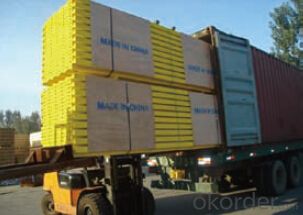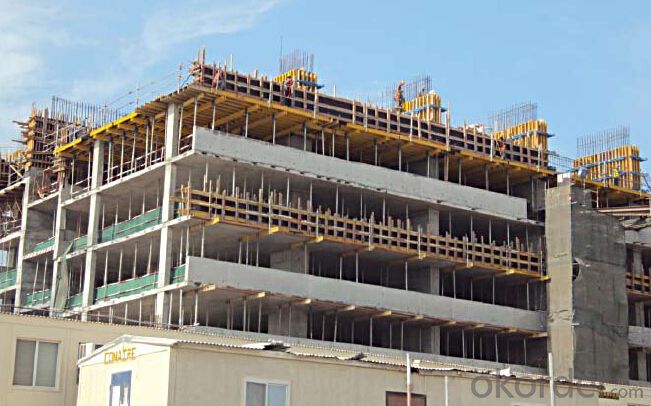Timber-Beam Formwork H20 for formwork and scaffolding systems
- Loading Port:
- Tianjin
- Payment Terms:
- TT OR LC
- Min Order Qty:
- 50 m²
- Supply Capability:
- 1000 m²/month
OKorder Service Pledge
OKorder Financial Service
You Might Also Like
Characteristics:
◆ Standardized production lines.
Supply capability: 3000m/day, Lmax = 6600mm.
◆ Finger jointing of the flange and web, the strength of timber beam is highly improved.
Max. shearing force failure load:40KN
◆ Well treated to prevent from water penetration or erosion, so the service life maximally
extended.
Normally, CNBM timber beam H20 can be used for 4 to 5 years, the exact using time would
depend on maintenance & storage.
◆ Robust caps at the end of the girders protect against damages.




- Q: What are the different surface finishes available for steel formwork?
- There are several surface finishes available for steel formwork, including smooth, textured, and coated finishes. Smooth finishes provide a sleek and polished appearance, while textured finishes create a rougher surface for enhanced grip and adhesion. Coated finishes, such as epoxy or galvanized coatings, offer additional protection against corrosion and wear.
- Q: What are the different types of formwork release oils used with steel formwork?
- There are typically two types of formwork release oils used with steel formwork: petroleum-based oils and water-based oils. Petroleum-based oils provide excellent adhesion and protection against rust, but they can be flammable and may have a strong odor. Water-based oils, on the other hand, are non-flammable and have a low odor, making them more environmentally friendly. However, they may not provide the same level of adhesion and rust protection as petroleum-based oils.
- Q: Can steel formwork be used for projects with high groundwater levels?
- Yes, steel formwork can be used for projects with high groundwater levels. Steel formwork is known for its durability and resistance to water, making it suitable for construction projects in areas with high groundwater levels. Its robustness and waterproof properties allow it to withstand the pressure and moisture from the groundwater, ensuring the stability and integrity of the structure being built.
- Q: Does steel formwork require special equipment for installation?
- Special equipment is necessary for the installation of steel formwork. Unlike traditional wooden or plastic formwork, steel formwork is heavier and stiffer, necessitating stronger and more specialized equipment for handling and installation. Cranes, forklifts, and hoists are commonly used to lift and position the steel panels and beams during installation. In addition, specific tools like clamps, braces, and connectors are required to secure the formwork system and maintain its stability while pouring concrete. The utilization of this specialized equipment not only simplifies the installation process but also guarantees the safety and stability of the formwork structure.
- Q: What are the different types of scaffolding used with steel formwork?
- There are several different types of scaffolding that can be used with steel formwork, each with their own unique features and benefits. 1. Tube and Coupler Scaffolding: This is the most commonly used type of scaffolding with steel formwork. It consists of vertical tubes connected by couplers, which allow for easy adjustment and flexibility in height and width. It is known for its strength and stability, making it suitable for heavy-duty construction projects. 2. H-frame Scaffolding: This type of scaffolding is similar to the tube and coupler system, but it features H-shaped frames instead of vertical tubes. It is lightweight and easy to assemble and disassemble, making it ideal for small-scale construction projects or areas with limited space. 3. Cuplock Scaffolding: Cuplock scaffolding is a modular system that uses pre-fabricated components, including vertical standards with cup joints and horizontal ledgers. It is quick to assemble and dismantle, making it a popular choice for time-sensitive projects. Cuplock scaffolding is also known for its versatility, as it can be used for both straight and curved structures. 4. Ringlock Scaffolding: This type of scaffolding is similar to cuplock scaffolding, but it uses a rosette joint system instead of cups. This allows for greater flexibility in assembling and adjusting the scaffolding. Ringlock scaffolding is known for its durability and high load-bearing capacity, making it suitable for heavy construction projects. 5. Kwikstage Scaffolding: Kwikstage scaffolding is a modular system that uses pre-fabricated components, including standards, ledgers, and transoms. It is quick to assemble and dismantle, and it offers excellent flexibility in terms of height and width adjustments. Kwikstage scaffolding is commonly used in construction projects that require frequent movement and repositioning of scaffolding. Overall, the choice of scaffolding used with steel formwork depends on the specific requirements of the construction project, including factors such as load-bearing capacity, flexibility, ease of assembly, and durability.
- Q: How does steel formwork contribute to the overall structural integrity of the building?
- Steel formwork contributes to the overall structural integrity of the building by providing a strong and durable framework for concrete construction. It ensures accurate and precise alignment of walls, columns, and beams, resulting in a structurally sound and stable building. The steel formwork system is capable of withstanding heavy loads and forces during construction and enhances the overall strength and stability of the structure. Additionally, the use of steel formwork allows for easy and efficient construction, reducing construction time and costs while ensuring high-quality and long-lasting buildings.
- Q: How does steel formwork compare to aluminum formwork in terms of cost?
- Compared to aluminum formwork, steel formwork generally tends to be more expensive in terms of cost. This is because steel is a stronger and more durable material, leading to higher production and material costs. Additionally, due to its heavier weight, steel formwork requires more labor for handling and installation. On the other hand, aluminum formwork is lighter and easier to handle, reducing labor costs and increasing construction efficiency. Furthermore, aluminum formwork can be reused multiple times, resulting in significant cost savings for multiple projects. In summary, steel formwork offers superior strength and durability but comes with a higher initial cost compared to aluminum formwork, considering material and labor factors.
- Q: Can steel formwork be used for earthquake-resistant concrete buildings?
- Indeed, earthquake-resistant concrete buildings can utilize steel formwork. Steel formwork pertains to a temporary structure employed to support and shape the concrete until it solidifies and becomes firm. It is renowned for its robustness, longevity, and capacity to endure substantial loads, which are desirable traits in earthquake-resistant construction. During seismic events, buildings endure lateral forces and vibrations. Given its strength and rigidity, steel formwork aids in distributing and transferring these forces across the entirety of the structure. It furnishes the necessary support to guarantee that the concrete walls, columns, and slabs remain intact amidst seismic occurrences. Moreover, steel formwork allows for precision and accuracy throughout the construction process. This is pivotal in earthquake-resistant buildings as any deviation from the intended design can undermine the structure's ability to withstand seismic forces. The utilization of steel formwork assures that the concrete components are adequately reinforced with steel bars and that all essential connections and joints are correctly positioned. Furthermore, steel formwork can be easily assembled, disassembled, and reused, rendering it a cost-effective solution for earthquake-resistant construction endeavors. This facilitates efficient construction practices, diminishes waste, and permits the formwork to serve multiple projects, thereby making it an environmentally friendly choice. Nonetheless, it is crucial to acknowledge that while steel formwork plays a crucial role in earthquake-resistant concrete buildings, it is not the sole determinant of the overall structural integrity. Other design considerations, including proper reinforcement detailing, sufficient foundation design, and appropriate structural analysis, hold equal importance. To conclude, steel formwork can be effectively employed in earthquake-resistant concrete buildings due to its strength, durability, and ability to withstand seismic forces. However, it must be accompanied by proper design and construction practices to ensure the overall structural resilience and safety of the building.
- Q: What are the considerations when designing steel formwork for architectural canopies?
- When designing steel formwork for architectural canopies, several important considerations need to be taken into account. These include: 1. Structural Integrity: The formwork must be designed to withstand the loads imposed by the canopy, including dead loads (self-weight), live loads (such as wind and snow), and any other potential loads such as hanging fixtures. The steel formwork should be structurally robust to ensure the stability and safety of the canopy. 2. Aesthetic Appeal: Architectural canopies are often designed to enhance the overall visual appeal of a building. Therefore, the steel formwork should be designed in a way that complements the desired aesthetics of the canopy. This could involve incorporating decorative elements, such as patterns or textures, into the formwork design. 3. Ease of Installation: The formwork should be designed for easy and efficient installation. This could involve using modular components that can be assembled quickly and easily on-site. It is also important to consider the weight and size of the formwork elements to ensure they can be handled and installed safely. 4. Durability and Maintenance: Steel formwork should be designed to withstand the environmental conditions to which it will be exposed. This may include protection against corrosion, UV radiation, and other potential causes of deterioration. Additionally, the formwork should be designed for easy maintenance and repair, if necessary. 5. Functionality: The formwork must be designed to accommodate any specific functional requirements of the canopy. This could include providing space for utility connections, such as lighting or drainage systems, or incorporating features such as rainwater collection systems. 6. Cost-effectiveness: The design of the steel formwork should consider the overall cost of the canopy project. This includes not only the initial cost of the formwork itself but also factors such as ease of transportation and installation, as well as long-term maintenance costs. Overall, the design of steel formwork for architectural canopies requires a careful balance between structural integrity, aesthetics, functionality, and cost-effectiveness. By considering these considerations, architects and engineers can ensure the successful implementation of canopies that are both visually appealing and structurally sound.
- Q: How does steel formwork contribute to easier formwork removal?
- Steel formwork contributes to easier formwork removal in several ways. Firstly, steel formwork is known for its high strength and durability. This means that it can withstand the pressure and weight of the concrete without deforming or warping. As a result, there is minimal damage or deformation to the formwork after the concrete is poured and cured. Secondly, steel formwork is designed with smooth surfaces, which allows for easy release of the formwork from the cured concrete. The smooth surface prevents the concrete from sticking to the formwork, making it easier to remove. This is particularly beneficial when working with complex shapes and intricate designs, as the formwork can be easily removed without causing any damage to the concrete. Additionally, steel formwork is often constructed with detachable parts or panels. This allows for easy assembly and disassembly of the formwork, making it quicker and more efficient to remove. The detachable parts also make it easier to clean and maintain the formwork, ensuring its longevity and reusability. Furthermore, steel formwork is highly resistant to moisture and chemicals, which are often present in the concrete or construction environment. This resistance prevents the formwork from deteriorating or becoming weakened over time. As a result, the formwork remains intact and in good condition, making it easier to remove after the concrete has set. Overall, the strength, durability, smooth surfaces, detachable parts, and resistance to moisture and chemicals make steel formwork an ideal choice for easier formwork removal. It not only simplifies the process but also ensures the quality and integrity of the concrete structure being built.
Send your message to us
Timber-Beam Formwork H20 for formwork and scaffolding systems
- Loading Port:
- Tianjin
- Payment Terms:
- TT OR LC
- Min Order Qty:
- 50 m²
- Supply Capability:
- 1000 m²/month
OKorder Service Pledge
OKorder Financial Service
Similar products
Hot products
Hot Searches
Related keywords

















